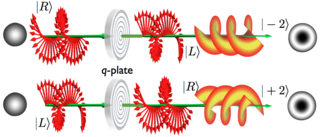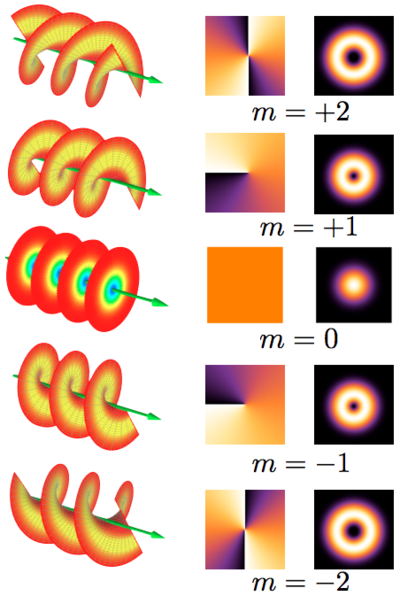
Diffraction is the interference or bending of waves around the corners of an obstacle or through an aperture into the region of geometrical shadow of the obstacle/aperture. The diffracting object or aperture effectively becomes a secondary source of the propagating wave. Italian scientist Francesco Maria Grimaldi coined the word diffraction and was the first to record accurate observations of the phenomenon in 1660.

Nonlinear optics (NLO) is the branch of optics that describes the behaviour of light in nonlinear media, that is, media in which the polarization density P responds non-linearly to the electric field E of the light. The non-linearity is typically observed only at very high light intensities (when the electric field of the light is >108 V/m and thus comparable to the atomic electric field of ~1011 V/m) such as those provided by lasers. Above the Schwinger limit, the vacuum itself is expected to become nonlinear. In nonlinear optics, the superposition principle no longer holds.

In optics, a Gaussian beam is an idealized beam of electromagnetic radiation whose amplitude envelope in the transverse plane is given by a Gaussian function; this also implies a Gaussian intensity (irradiance) profile. This fundamental (or TEM00) transverse Gaussian mode describes the intended output of many lasers, as such a beam diverges less and can be focused better than any other. When a Gaussian beam is refocused by an ideal lens, a new Gaussian beam is produced. The electric and magnetic field amplitude profiles along a circular Gaussian beam of a given wavelength and polarization are determined by two parameters: the waistw0, which is a measure of the width of the beam at its narrowest point, and the position z relative to the waist.
Matter waves are a central part of the theory of quantum mechanics, being half of wave–particle duality. At all scales where measurements have been practical, matter exhibits wave-like behavior. For example, a beam of electrons can be diffracted just like a beam of light or a water wave.

Optical tweezers are scientific instruments that use a highly focused laser beam to hold and move microscopic and sub-microscopic objects like atoms, nanoparticles and droplets, in a manner similar to tweezers. If the object is held in air or vacuum without additional support, it can be called optical levitation.

A metamaterial is any material engineered to have a property that is rarely observed in naturally occurring materials. They are made from assemblies of multiple elements fashioned from composite materials such as metals and plastics. These materials are usually arranged in repeating patterns, at scales that are smaller than the wavelengths of the phenomena they influence. Metamaterials derive their properties not from the properties of the base materials, but from their newly designed structures. Their precise shape, geometry, size, orientation and arrangement gives them their smart properties capable of manipulating electromagnetic waves: by blocking, absorbing, enhancing, or bending waves, to achieve benefits that go beyond what is possible with conventional materials.

Electron optics is a mathematical framework for the calculation of electron trajectories in the presence of electromagnetic fields. The term optics is used because magnetic and electrostatic lenses act upon a charged particle beam similarly to optical lenses upon a light beam.

An optical vortex is a zero of an optical field; a point of zero intensity. The term is also used to describe a beam of light that has such a zero in it. The study of these phenomena is known as singular optics.
The Gross–Pitaevskii equation describes the ground state of a quantum system of identical bosons using the Hartree–Fock approximation and the pseudopotential interaction model.

The Goos–Hänchen effect (named after Hermann Fritz Gustav Goos and Hilda Hänchen is an optical phenomenon in which linearly polarized light undergoes a small lateral shift when totally internally reflected. The shift is perpendicular to the direction of propagation in the plane containing the incident and reflected beams. This effect is the linear polarization analog of the Imbert–Fedorov effect.
Speckle, speckle pattern, or speckle noise is a granular noise texture degrading the quality as a consequence of interference among wavefronts in coherent imaging systems, such as radar, synthetic aperture radar (SAR), medical ultrasound and optical coherence tomography. Speckle is not external noise; rather, it is an inherent fluctuation in diffuse reflections, because the scatterers are not identical for each cell, and the coherent illumination wave is highly sensitive to small variations in phase changes.

The angular momentum of light is a vector quantity that expresses the amount of dynamical rotation present in the electromagnetic field of the light. While traveling approximately in a straight line, a beam of light can also be rotating around its own axis. This rotation, while not visible to the naked eye, can be revealed by the interaction of the light beam with matter.

Orbital angular momentum multiplexing is a physical layer method for multiplexing signals carried on electromagnetic waves using the orbital angular momentum (OAM) of the electromagnetic waves to distinguish between the different orthogonal signals.

An electromagnetic metasurface refers to a kind of artificial sheet material with sub-wavelength thickness. Metasurfaces can be either structured or unstructured with subwavelength-scaled patterns in the horizontal dimensions.

A q-plate is an optical device that can form a light beam with orbital angular momentum (OAM) from a beam with well-defined spin angular momentum (SAM). Q-plates are based on the SAM-OAM coupling that may occur in media that are both anisotropic and inhomogeneous, such as an inhomogeneous anisotropic birefringent waveplate. Q-plates are also currently realized using total internal reflection devices, liquid crystals, metasurfaces based on polymers, and sub-wavelength gratings.

JCMsuite is a finite element analysis software package for the simulation and analysis of electromagnetic waves, elasticity and heat conduction. It also allows a mutual coupling between its optical, heat conduction and continuum mechanics solvers. The software is mainly applied for the analysis and optimization of nanooptical and microoptical systems. Its applications in research and development projects include dimensional metrology systems, photolithographic systems, photonic crystal fibers, VCSELs, Quantum-Dot emitters, light trapping in solar cells, and plasmonic systems. The design tasks can be embedded into the high-level scripting languages MATLAB and Python, enabling a scripting of design setups in order to define parameter dependent problems or to run parameter scans.

Electrons in free space can carry quantized orbital angular momentum (OAM) projected along the direction of propagation. This orbital angular momentum corresponds to helical wavefronts, or, equivalently, a phase proportional to the azimuthal angle. Electron beams with quantized orbital angular momentum are also called electron vortex beams.
Natalia M. Litchinitser is an Electrical Engineer and Professor at Duke University. She works on optical metamaterials and their application in photonic devices. Litchinitser is a Fellow of the American Physical Society, The Optical Society and the Institute of Electrical and Electronics Engineers.
Alexey Okulov is a Soviet and Russian physicist, the author of pioneering works in laser physics and theoretical physics.
In photonics, a meta-waveguide is a physical structures that guides electromagnetic waves with engineered functional subwavelength structures. Meta-waveguides are the result of combining the fields of metamaterials and metasurfaces into integrated optics. The design of the subwavelength architecture allows exotic waveguiding phenomena to be explored.












































